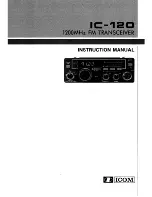
4
LM
LECTROSONICS, INC.
LM Block Diagram
GENERAL TECHNICAL DESCRIPTION
Phase Locked Loop
Voltage
Controlled
Oscillator
Freq
Switches
11001001
A-D
Converter
Digital Signal Processor
11001001
D-A
Converter
Shunt
Limiter
Bicolor
Modulation
LEDs
Microprocessor
9V
Battery
Switching
Power
Supply
+3.3v
+1.8v
+9v
-3v
Hi/Lo
Pass
Filter
Audio
Encoded
Audio +
Pilot Tone
11.3 MHz
Reference
Bicolor
Power
LED
Audio
Level
Input
Amp
Final
Amplifier
+5V Bias
Supply
5
4
3
2
1
Mic
Jack
<--See
5-Pin Input Jack Wiring
for details.
INTRODUCTION
The Digital Hybrid Wireless
™
system uses 75 kHz wide deviation for an extremely high signal to noise ratio. The
switching power supplies provide constant voltages to the transmitter circuits from the beginning (9.3 VDC) to the
end (5.5 VDC) of battery life. The input amplifier uses an ultra low noise operational amplifier (op amp) for quiet
operation. It is gain controlled with a wide range dual envelope input limiter that tames input signal peaks over 30 dB
above full modulation.
DIGITAL HYBRID TECHNOLOGY
All wireless links suffer from channel noise to some degree, and all wireless microphone systems seek to minimize
the impact of that noise on the desired signal. Conventional analog systems use compandors for enhanced dynamic
range, at the cost of subtle artifacts (known as “pumping” and “breathing”). Wholly digital systems defeat the noise
by sending the audio information in digital form, at the cost of some combination of power, bandwidth, operating
range and resistance to interference.
The Lectrosonics Digital Hybrid Wireless
™
system overcomes channel noise in a dramatically new way, digitally
encoding the audio in the transmitter and decoding it in the receiver, yet still sending the encoded information via an
analog FM wireless link. This proprietary algorithm is not a digital implementation of an analog compandor but a
technique which can be accomplished only in the digital domain. (The patent is still pending, so we cannot publish
detailed information).
Channel noise still has an impact on received signal quality and will eventually overwhelm the receiver. The Digital
Hybrid Wireless
™
system simply encodes the signal to use a noisy channel as efficiently and robustly as possible,
yielding audio performance that rivals that of wholly digital systems, without the power, noise and bandwidth prob-
lems inherent in digital transmission. As always, these advantages come at a cost. The Digital Hybrid Wireless
™
system requires fairly intensive digital processing in both the transmitter and the receiver. These processors cost
money, take up space and consume power. The Digital Hybrid Wireless
TM
system also requires that the underlying
RF link be of excellent quality, with better frequency response and distortion characteristics than that required by
conventional analog wireless systems.
Because it uses an analog FM link, Digital Hybrid Wireless
™
enjoys all the benefits of conventional FM wireless
systems, such as excellent range, efficient use of RF spectrum, and long battery life. However, unlike conventional
FM systems, Digital Hybrid Wireless
™
has done away with the analog compandor and its artifacts.
Содержание LM
Страница 2: ...2 LM LECTROSONICS INC ...
Страница 15: ...15 Frequency Agile UHF Belt Pack Transmitter Rio Rancho NM USA ...


































